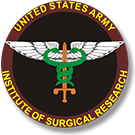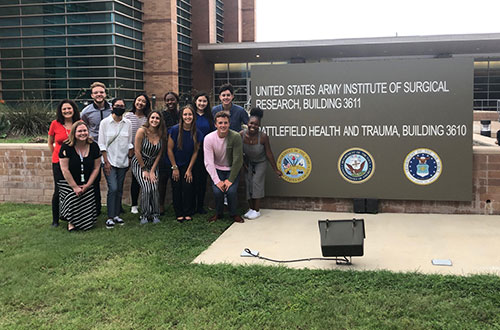College interns complete summer internship program at USAISR
The U.S. Army Institute of Surgical Research (ISR) at Joint Base San Antonio-Fort Sam Houston, Texas, completed its annual 10-week Summer Undergrad Research Program (SURP) with 12 college students from throughout the nation. The summer program is sponsored by the Oak Ridge Institute for Science and Education (ORISE) and aims to expose college students to a laboratory environment and provide them with invaluable research experience.
This year's program was again held virtually (vSURP) due to restrictions related to the COVID-19 pandemic. Nonetheless, as with the on-site program, the interns were paired with ISR researchers who served as mentors and oversaw their work on combat casualty care research projects.
"In the past, the focus of the program has been to provide hands-on experiences for the students by allowing them to participate in-person on research activities in selected laboratories here," said Carmen Hinojosa-Laborde, Ph.D., research physiologist and SURP co-director. "The objective of this year's program was to provide the students with the opportunity to participate virtually on research experiences. The focus of research experiences depended on the mentors involved. We have a wide range of mentors who cover the majority of the Combat Casualty Research Teams (CRTs)."
In order for the program to succeed virtually, the mentors had to design projects that could be conducted remotely and all interns and ISR mentors agreed to work remotely during the summer. Anna Parry, a biochemistry student at Colorado State University, learned about the summer program through Handshake, a website CSU uses to help students find job opportunities.
"I applied because I was looking for a way to get my foot in the door in research," said Parry. "I did not have previous research experience, but I have always thought I wanted it to be a big part of my career. I was not expecting to get an internship after my first year in college, but I was interested in the projects ISR offered and wanted to pursue the opportunity."
During the ten weeks of vSURP, Parry and her colleagues contributed to the writing of a scientific paper, participated in a weekly journal club, and attended a weekly seminar which summarized the research in a different ISR CRT each week. The journal club meetings and seminars were conducted via teleconference.
"The student-mentor communications for the individual writing projects were coordinated by the mentor, said Natasha Sosanya, Ph.D., staff scientist and SURP co-director. "We were able to offer an optional on-site visit in July where the students were able meet with their mentors, as well as tour the Burn Center, ISR research labs and the Center for the Intrepid.
The capstone event of the program came during the first week of August, when the students presented a poster discussing the findings of their research efforts.
"I was investigating platelet function, specifically, I mapped out an intracellular pathway that controlled platelet function," Parry said. "My focus was protein kinase C. I spent a lot of time performing a literature review and then using that information to create my map. During my final poster presentation, I went over my map in detail and explained ways the information could be used for targeted drug action or resuscitation strategies."
Parry also said that she truly enjoyed the program and working with her mentor.
"It was a great experience, and my mentor [Dan Darlington, Ph.D.] was fantastic," added Parry. "His guidance made a huge difference for me. While it's true I would have preferred to be physically in the lab, I am very glad I participated and got to interact with so many people."
Hinojosa-Laborde and Sosanya agreed that the summer program was a resounding success with the productive students producing great science.
"The ISR vSURP worked to provide undergraduate students completing degree programs in science, technology, engineering and mathematics [STEM] an experience of participating in scientific research with a unique military medicine prospective," added Sosanya.
Said Hinojosa-Laborde, "The program provided a bridge between the classroom and real-world experiences and aimed to increase the number of future scientists to support the ISR mission."
Parry said she would highly recommend anyone who is thinking about applying for the program to do so.
"Virtual or in-person, it is worth it," she said. "Especially if they have the opportunity to work with Dan! It gave me a lot of insight into what I'm looking for in the future."














